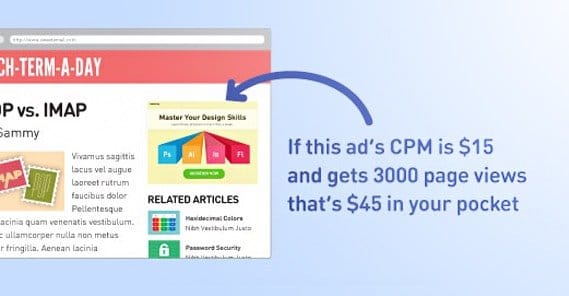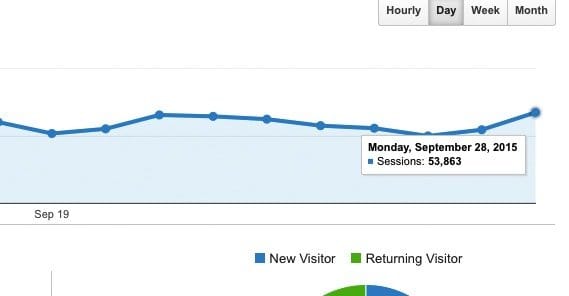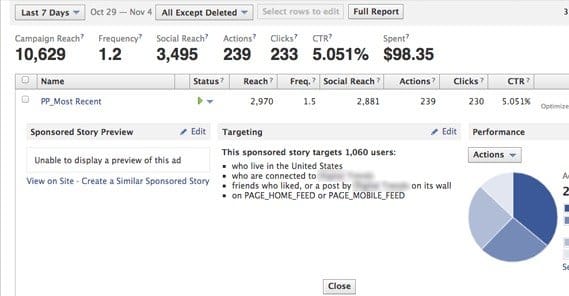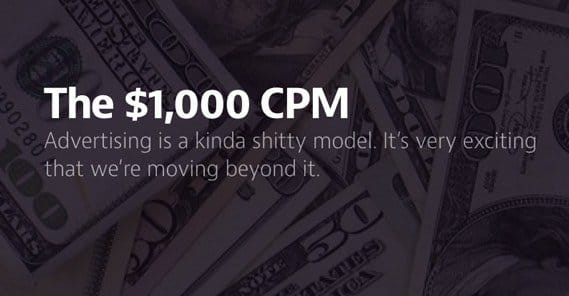How Large Sites Increase Ad Revenue by Purchasing Traffic

Most of what I write for this site is geared towards small blogs, small businesses and individual operations, but there are some larger businesses that swing by to read. A lot of the time, I’m not saying anything new to them, though I might be putting it in a new light or guiding them to new topics. This time, though, I’m going to share one of their secrets. Large sites often buy traffic to supplement the traffic they receive, and they leverage that traffic to make additional money through ads. The question is, how?
The Benefits of Being Big
It takes a long time to grow, but growth is difficult to reverse past a certain point. Websites have a certain critical mass, after which they grow on their own and become major web entities. Facebook had to start somewhere, Reddit wasn’t always a massive hub of traffic, and Imgur was founded as a replacement for a previous popular web host, Waffleimages, etc.
That’s not to say that big sites are all too big to fail. How many revisions has Digg gone through? Who still uses MySpace? Do you even remember Friendster? Large sites fade from the public mind when they’re surpassed, but that’s not surprising. It’s also beside the point. Large sites, any site above a middling amount of traffic, has some resources to throw around.
For one thing, large sites are already making money. You don’t grow to be a large site and then start advertising, your users will rebel and you’ll collapse under the weight of the constantly growing hosting expenses without income. The only large sites that can afford to go ad-free are those owned and operated by firms that have more than enough money to throw around.
Large sites, then, are typically bringing in money through some means or another. Many of them use ads, PPC ads or PPM ads, either work. Others use affiliate marketing. Many sell products. The point is, there’s a cash flow, and there are people who do what is necessary to create that cash flow.
Speaking of users, large sites have a not-insignificant userbase. That’s what makes them large sites, right? It’s not about the size of your blog posts or the number of pages on your domain, it’s about the number of people coming in for one reason or another.
Large sites tend to have multiple traffic sources. They pay for traffic through ads from Facebook and Google, among other ad networks. They get a lot of traffic from organic search results, both because they know what they’re doing with SEO and because at a certain point the size of a site helps snowball it into the rankings. They get a lot of referrals from social media, because these days large sites are only large because people love to share them, or the content on them.
All of this traffic allows them the freedom and flexibility necessary to diversify their financial portfolios. Large sites like to diversify their monetization to ensure greater stability. Financial stability in the web world is like a table. A table with one leg isn’t very stable – and don’t get smart with me in the comments about tables with one central leg, they spread out at the bottom, it doesn’t count – nor is a table with two. Three is the minimum necessary, which is why many large sites have ads of various sorts and a shop selling, at the very least, merchandise. Many also offer slots for sponsored posts and the like.
Large Sites Buying Traffic
I’ve talked about buying traffic before, it’s not an uncommon subject. There are two salient points I’ve covered before that I’m going to cover again, because they’re relevant to this discussion. The first is traffic quality, and the second is making money with purchased traffic.
So, traffic quality. When you’re buying traffic online, it comes in a few different forms. Different people have different ways of categorizing this traffic, but I like to use this one.
- At the bottom of the barrel is the bot traffic. It’s incredibly cheap, but it’s cheap for a reason. The traffic is just hits from a piece of software, nothing more than browser refreshes. It won’t buy anything, it won’t click ads, and it’s generally valueless.
- Just above bot traffic is clickfarm traffic. This is also pretty bad, but slightly more useful if you’re setting up a system to game an ad network out of some cash. It’s real people, so it passes many of the filters that block bots, but those users aren’t interested in your site. They don’t care what you sell and they won’t click your ads unless you’re paying them to do it.
- Above that is the disinterested traffic. These are real users, they just don’t really care about your site. A lot of traffic exchanges provide this kind of traffic; users who are in it to browse and make money for themselves, not to find something interesting on your site.
- At the top is the interested, relevant traffic. This is the kind of traffic you get from ads like Facebook when they’re targeted properly. They’re interested in your site, they like your brand, and they’re perfectly willing to convert if the opportunity arises.
Small sites looking to buy traffic and make money off it tend to go for clickfarm traffic at the bare minimum. Bot traffic works, sometimes, but you lose out on a lot of it due to filters. If you buy 1,000 hits for PPM ads that give you $1 for a 1,000 hits, but that ad network detects and filters 75% of the bots, you’re losing out. You would need to buy 4,000 hits to get 1,000 hits counted, and 4,000 hits are very likely going to cost more than the $1 you get out of it.
Clickfarm traffic will get around more of the filters, but at the low end, some bots will sneak through, and some ad networks will filter traffic from specific geographic areas. Depending on the network, you might have just as low a success rate with clickfarm traffic as with bots.
For this post, I’m not talking about small sites. I’m talking about larger sites with more resources to throw around. To these sites, I recommend going for disinterested traffic at the worst. It will be more expensive, but that’s okay. You have ways to deal with that which are unavailable to smaller sites.
Chances are, large sites are already buying high quality, targeted traffic through Facebook, Google, and/or one of the major ad networks. It all depends on the marketing company they’re using.
Making Money with Purchased Traffic
So, that’s traffic quality. What about making money with that traffic? As I mentioned, you have to worry about filters first and foremost. As a large site, as long as you’re targeting the higher quality types of traffic, you don’t have to worry quite as much.
There are three primary ways to make money from incoming traffic online.
- Views. PPM ads, or ads that pay you an amount of money per thousand views of the ads, make up this category. They tend to be low paying, and you won’t be making much money unless you have significant volume.
- Actions. PPC ads and lead-based affiliate marketing falls into this category. PPC ads pay you when a user clicks the ad, as do lead-generation ads. Normal affiliate ads require a user to make a purchase, which falls into the next category.
- Sales. Affiliate marketing in the traditional sense falls into this category, as does native sales. Selling a product yourself can be very lucrative, if you have the real traffic necessary to convert.
Large sites are going to be leveraging all three, whenever possible. They will have a mixture of PPM and PPC ads, and will have some way of making sales or referring people to an affiliate for sales.
How does buying traffic help with this? It depends on the type of traffic you’re buying.
The first form of traffic buying is the high quality traffic from Facebook ads and the like. You know the type. This is made up of legitimate users, and so you do your best to send those users to pages with affiliate offers or products to buy. You don’t want to send your low quality traffic to these pages, because they don’t care enough to buy. This is strictly for ad-based traffic and organic traffic whenever possible.
As for lower quality purchased traffic, this is where it gets interesting. As a large site, you can leverage some of your influence to get better rates on PPM ads, and you can use those ads to generate money out of traffic you buy.
To make sure you make money, you need to adjust two factors in your favor. The first is the cost of the traffic you’re buying, and the second is the value of the ads you’re showing. You could have insanely cheap traffic, but if the PPM rates are measured in pennies, you can still lose out. On the other hand, you could have very expensive traffic, but if you’re making $100 per thousand views, you’re going to be making a profit.
There’s a floor to how cheap you can allow your traffic to be as a large site. Thankfully, you have the budget to expend on slightly higher quality traffic, so you can be assured of success through PPM filters. Test out different traffic suppliers and monitor the traffic they send you. If it’s primarily bots and people from third world countries, find a different supplier. Unless you have a specific scheme to monetize that traffic, of course.
I’m going to make a bit of a digression here. Clickfarm traffic almost always comes from so-called “developing nations” like Malaysia, Bangladesh, India, Pakistan, and others in the middle east. The cost of living is low so these people can provide web services – like social follows or website hits – for a very low price and still make a living.
Under most circumstances, the websites buying this kind of traffic don’t know that it’s not very valuable to them. It makes sense, though. If they’re making $5 a day, they’re not going to buy your $100 software or your $500 designer underwear.
The exception as a large site is if you have some way to cater to these people. If you have a cheap product and you can do business in one of these countries, legally and profitably, buying ultra-cheap traffic can be insanely lucrative. This is, however, a tough market to break into, so don’t try it unless you’re quite sure of your success.
Anyways. As I was saying, to maintain traffic quality, there’s a floor to the price of traffic. Therefore, most of your room for profit comes from pushing up the ceiling on the payments you’re getting. Thankfully, as a large site, you have a lot of power for negotiation.
Getting the Best PPM Rates
Large sites, as well as high profile content creators, have the capability necessary to leverage their size and their audience into higher CPM rates. The trick is to realize what features you have going for you, and how to leverage them.
The first is, of course, audience size. Large sites can leverage their size in order to get better rates with ad networks, on promise of significant volume. If you have 100,000 monthly viewers, you can tell the ad networks that you have that level of traffic consistently, and you can show them traffic records to prove it. In fact, some of the most high-tier and exclusive ad networks only allow sites with at least a certain high level of monthly viewership.
To this end, if you’re buying traffic to funnel into CPM ads, you’ll want to start carefully. Two things will kill the deal for you; a sudden spike in traffic, or low traffic prior to enrolling. The sudden spike, visible in your analytics when you let the ad networks look, will indicate to them that you started buying traffic to look better and get better results. They might give you a little benefit of the doubt, but not much.
As for having low traffic prior, it’s all about expectations. If you tell an ad network that you’re going to be sending them around 100,000 monthly hits, and you end up sending them 500,000, they’re going to get suspicious. They’ll scrutinize your traffic closer and may find something they don’t like. You don’t want to be removed from the program, do you?
Therefore, start buying your traffic several months beforehand, and do it gradually. If you have 100,000 monthly hits and you’re growing by around 5,000 per month, start paying for an extra 5,000 per month. Your growth rate doubles, but it’s still reasonable to have achieved through normal methods. It doesn’t look out of place like a spike.
The second factor is the location of the site, and it’s pretty simple. Sites that specialize in US traffic have an easier time of it, because international traffic tends to be less valuable. Like I said; clickfarms don’t convert, so the ad networks don’t want to pay a lot for traffic coming from international sources that won’t convert.
Sites with specific niches can be more valuable if they find niche advertising. This is why the Gawker network has a bunch of different sites in different niches, like Gizmodo and Kotaku and Jalopnik, rather than one megasite covering all of those topics. They provide, ostensibly, more targeted traffic. Kotaku is providing traffic that is interested in gaming, so gaming advertisers will pay more for those hits.
Sites with great long-term potential will have more valuable ads than sites that are going to be forgotten in a month. This is the barb on the blade of viral exposure. A site that improved dramatically due to a viral surge might look good now, but six months from now it might be entirely forgotten. The exception is if the site is based entirely around repeated viral exposures, like UpWorthy.
Some of this isn’t something you can adjust, it’s just based on how you built your site. Some, though, are factors you can sway in your favor before you apply to high-tier ad networks and try to get high priced ads.
You should also analyze the numbers before you go all in. Figure out what the cost of buying traffic is, for a month of traffic. Figure out how much of that traffic will be filtered by the ad network, based on historical rates. Figure out how much you can expect to make – or lose – from the transaction, if all goes according to play.
It’s also a good idea to have a backup plan or a secondary route for monetizing this traffic. Exposing purchased traffic to CPM ads is good, but you can also expose them to affiliate ads or products you sell. Again, don’t funnel them all to your landing pages. Instead, just make sure some affiliate links are placed where they can see them. Every secondary conversion is a bonus and makes your life that much easier.
 ContentPowered.com
ContentPowered.com







